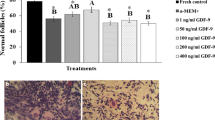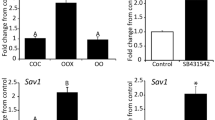Abstract
Purpose
Foxo3 protein is required in the oocyte nucleus for the maintenance of primordial follicles in a dormant state. PI3K/AKT-dependent phosphorylation of Foxo3 leads to its relocalization to the cytoplasm and subsequent follicular activation. However, the nature of the upstream signals controlling Foxo3 activity and subcellular localization remains unknown. We aimed to study the in vitro effects of Kit ligand (stem cell factor) on the subcellular localization of Foxo3 in primordial follicles within the postnatal mouse ovary.
Methods
This was an in vitro study using explants of intact neonatal mouse ovaries. The study was performed in laboratory animal facility and basic science research laboratory at a University Hospital. The animals used for this study were FVB mice. Neonatal FVB mice ovaries at postnatal day 7 (PD7) were harvested and incubated in culture medium (DMEM) at 37 °C and 5 % CO2 for 60–90 min with (n = 3) or without (n = 3) Kit ligand at 150 ng/mL (8 nM). Similar experimental conditions were used to establish a dose–response curve for the effects of Kit ligand and assess the effects of imatinib (small molecule inhibitor of the Kit receptor). Immunofluorescence was used to identify the subcellular location of Foxo3 in oocytes. Proportions of cytoplasmic versus nuclear Foxo3 in primordial follicles were determined.
Results
Kit ligand treatment increased the cytoplasmic localization of Foxo3 from 40 % in the untreated ovaries to 74 % in the treated group (p = 0.007 in paired samples and p = 0.03 in unpaired samples). Furthermore, this effect was reversible with imatinib (p = 0.005). A dose–response curve for Kit ligand treatment showed that maximum effect was seen at 150 ng/mL.
Conclusion
Kit ligand treatment in vitro increases the proportion of cytoplasmic Foxo3 in primordial follicles at PD7, lending support to the idea that Kit receptor/ligand controls Foxo3 activity in the context of primordial follicle activation




Similar content being viewed by others
References
Pepling ME. Follicular assembly: mechanisms of action. Reproduction. 2012;143(2):139–49. doi:10.1530/REP-11-0299.
Hirshfield AN. Development of follicles in the mammalian ovary. Int Rev Cytol. 1991;124:43–101.
Reddy P, Zheng W, Liu K. Mechanisms maintaining the dormancy and survival of mammalian primordial follicles. Trends Endocrinol Metab. 2010;21(2):96–103. doi:10.1016/j.tem.2009.10.001.
Lintern-Moore S, Moore GP. The initiation of follicle and oocyte growth in the mouse ovary. Biol Reprod. 1979;20(4):773–8.
Peters H, Byskov AG, Himelstein-Braw R, Faber M. Follicular growth: the basic event in the mouse and human ovary. J Reprod Fertil. 1975;45(3):559–66.
Eppig JJ, O’Brien MJ. Development in vitro of mouse oocytes from primordial follicles. Biol Reprod. 1996;54(1):197–207.
Peters H, Byskov AG, Lintern-Moore S, Faber M, Andersen M. The effect of gonadotrophin on follicle growth initiation in the neonatal mouse ovary. J Reprod Fertil. 1973;35(1):139–41.
Matzuk MM, Burns KH, Viveiros MM, Eppig JJ. Intercellular communication in the mammalian ovary: oocytes carry the conversation. Science. 2002;296(5576):2178–80. doi:10.1126/science.1071965.
Albertini DF, Barrett SL. Oocyte-somatic cell communication. Reprod Suppl. 2003;61:49–54.
John GB, Shirley LJ, Gallardo TD, Castrillon DH. Specificity of the requirement for Foxo3 in primordial follicle activation. Reproduction. 2007;133(5):855–63. doi:10.1530/REP-06-0051.
Castrillon DH, Miao L, Kollipara R, Horner JW, DePinho RA. Suppression of ovarian follicle activation in mice by the transcription factor Foxo3a. Science. 2003;301(5630):215–8. doi:10.1126/science.1086336.
Gallardo TD, John GB, Shirley L, Contreras CM, Akbay EA, Haynie JM, et al. Genomewide discovery and classification of candidate ovarian fertility genes in the mouse. Genetics. 2007;177(1):179–94. doi:10.1534/genetics.107.074823.
Tarnawa ED, Baker MD, Aloisio GM, Carr BR, Castrillon DH. Gonadal expression of Foxo1, but not Foxo3, is conserved in diverse mammalian species. Biol Reprod. 2013;88(4):103. doi:10.1095/biolreprod.112.105791.
Reddy P, Liu L, Adhikari D, Jagarlamudi K, Rajareddy S, Shen Y, et al. Oocyte-specific deletion of Pten causes premature activation of the primordial follicle pool. Science. 2008;319(5863):611–3. doi:10.1126/science.1152257.
Adhikari D, Zheng W, Shen Y, Gorre N, Hamalainen T, Cooney AJ, et al. Tsc/mTORC1 signaling in oocytes governs the quiescence and activation of primordial follicles. Hum Mol Genet. 2010;19(3):397–410. doi:10.1093/hmg/ddp483.
Adhikari D, Flohr G, Gorre N, Shen Y, Yang H, Lundin E, et al. Disruption of Tsc2 in oocytes leads to overactivation of the entire pool of primordial follicles. Mol Hum Reprod. 2009;15(12):765–70. doi:10.1093/molehr/gap092.
Pangas SA. Regulation of the ovarian reserve by members of the transforming growth factor beta family. Mol Reprod Dev. 2012;79(10):666–79. doi:10.1002/mrd.22076.
Rajareddy S, Reddy P, Du C, Liu L, Jagarlamudi K, Tang W, et al. p27kip1 (cyclin-dependent kinase inhibitor 1B) controls ovarian development by suppressing follicle endowment and activation and promoting follicle atresia in mice. Mol Endocrinol. 2007;21(9):2189–202. doi:10.1210/me.2007-0172.
Sullivan SD, Castrillon DH. Insights into primary ovarian insufficiency through genetically engineered mouse models. Semin Reprod Med. 2011;29(4):283–98. doi:10.1055/s-0031-1280914.
Uhlenhaut NH, Treier M. Forkhead transcription factors in ovarian function. Reproduction. 2011;142(4):489–95. doi:10.1530/REP-11-0092.
Zhao Y, Wang Y, Zhu WG. Applications of post-translational modifications of FoxO family proteins in biological functions. J Mol Cell Biol. 2011;3(5):276–82. doi:10.1093/jmcb/mjr013.
Christian M, Lam EW, Wilson MS, Brosens JJ. FOXO transcription factors and their role in disorders of the female reproductive tract. Curr Drug Targets. 2011;12(9):1291–302.
John GB, Gallardo TD, Shirley LJ, Castrillon DH. Foxo3 is a PI3K-dependent molecular switch controlling the initiation of oocyte growth. Dev Biol. 2008;321(1):197–204. doi:10.1016/j.ydbio.2008.06.017.
Carracedo A, Pandolfi PP. The PTEN-PI3K pathway: of feedbacks and cross-talks. Oncogene. 2008;27(41):5527–41. doi:10.1038/onc.2008.247.
Engelman JA, Luo J, Cantley LC. The evolution of phosphatidylinositol 3-kinases as regulators of growth and metabolism. Nat Rev Genet. 2006;7(8):606–19. doi:10.1038/nrg1879.
Thorpe LM, Yuzugullu H, Zhao JJ. PI3K in cancer: divergent roles of isoforms, modes of activation and therapeutic targeting. Nat Rev Cancer. 2015;15(1):7–24. doi:10.1038/nrc3860.
Baker MD, Ezzati M, Aloisio GM, Tarnawa ED, Cuevas I, Nakada Y, et al. The small GTPase Rheb is required for spermatogenesis but not oogenesis. Reproduction. 2014;147(5):615–25. doi:10.1530/REP-13-0304.
McLaughlin EA, McIver SC. Awakening the oocyte: controlling primordial follicle development. Reproduction. 2009;137(1):1–11. doi:10.1530/REP-08-0118.
Merkwitz C, Lochhead P, Tsikolia N, Koch D, Sygnecka K, Sakurai M, et al. Expression of KIT in the ovary, and the role of somatic precursor cells. Prog Histochem Cytochem. 2011;46(3):131–84. doi:10.1016/j.proghi.2011.09.001.
Thomas FH, Vanderhyden BC. Oocyte-granulosa cell interactions during mouse follicular development: regulation of kit ligand expression and its role in oocyte growth. Reprod Biol Endocrinol. 2006;4:19. doi:10.1186/1477-7827-4-19.
Hutt KJ, McLaughlin EA, Holland MK. KIT/KIT ligand in mammalian oogenesis and folliculogenesis: roles in rabbit and murine ovarian follicle activation and oocyte growth. Biol Reprod. 2006;75(3):421–33. doi:10.1095/biolreprod.106.051516.
Hutt KJ, McLaughlin EA, Holland MK. Kit ligand and c-Kit have diverse roles during mammalian oogenesis and folliculogenesis. Mol Hum Reprod. 2006;12(2):61–9. doi:10.1093/molehr/gal010.
Parrott JA, Skinner MK. Kit-ligand/stem cell factor induces primordial follicle development and initiates folliculogenesis. Endocrinology. 1999;140(9):4262–71. doi:10.1210/endo.140.9.6994.
Yoshida H, Takakura N, Kataoka H, Kunisada T, Okamura H, Nishikawa SI. Stepwise requirement of c-kit tyrosine kinase in mouse ovarian follicle development. Dev Biol. 1997;184(1):122–37. doi:10.1006/dbio.1997.8503.
Serve H, Hsu YC, Besmer P. Tyrosine residue 719 of the c-kit receptor is essential for binding of the P85 subunit of phosphatidylinositol (PI) 3-kinase and for c-kit-associated PI 3-kinase activity in COS-1 cells. J Biol Chem. 1994;269(8):6026–30.
John GB, Shidler MJ, Besmer P, Castrillon DH. Kit signaling via PI3K promotes ovarian follicle maturation but is dispensable for primordial follicle activation. Dev Biol. 2009;331(2):292–9. doi:10.1016/j.ydbio.2009.05.546.
Kissel H, Timokhina I, Hardy MP, Rothschild G, Tajima Y, Soares V, et al. Point mutation in kit receptor tyrosine kinase reveals essential roles for kit signaling in spermatogenesis and oogenesis without affecting other kit responses. EMBO J. 2000;19(6):1312–26. doi:10.1093/emboj/19.6.1312.
Zhang H, Risal S, Gorre N, Busayavalasa K, Li X, Shen Y, et al. Somatic cells initiate primordial follicle activation and govern the development of dormant oocytes in mice. Curr Biol. 2014;24(21):2501–8. doi:10.1016/j.cub.2014.09.023.
Reddy P, Shen L, Ren C, Boman K, Lundin E, Ottander U, et al. Activation of Akt (PKB) and suppression of FKHRL1 in mouse and rat oocytes by stem cell factor during follicular activation and development. Dev Biol. 2005;281(2):160–70. doi:10.1016/j.ydbio.2005.02.013.
Blume-Jensen P, Hunter T. Oncogenic kinase signalling. Nature. 2001;411(6835):355–65. doi:10.1038/35077225.
Liu K. Stem cell factor (SCF)-kit mediated phosphatidylinositol 3 (PI3) kinase signaling during mammalian oocyte growth and early follicular development. Front Biosci. 2006;11:126–35.
Wehrle-Haller B, Weston JA. Soluble and cell-bound forms of steel factor activity play distinct roles in melanocyte precursor dispersal and survival on the lateral neural crest migration pathway. Development. 1995;121(3):731–42.
Tajima Y, Moore MA, Soares V, Ono M, Kissel H, Besmer P. Consequences of exclusive expression in vivo of Kit-ligand lacking the major proteolytic cleavage site. Proc Natl Acad Sci U S A. 1998;95(20):11903–8.
Ismail RS, Dube M, Vanderhyden BC. Hormonally regulated expression and alternative splicing of kit ligand may regulate kit-induced inhibition of meiosis in rat oocytes. Dev Biol. 1997;184(2):333–42. doi:10.1006/dbio.1997.8531.
Author information
Authors and Affiliations
Corresponding authors
Ethics declarations
Conflict of interest
The authors declare that they have no conflict of interest.
Funding
This work was supported by NICHD R01 HD048690 grant to D.H.C.
Additional information
Capsule
In the context of primordial follicle activation, Kit signaling increases the proportion of cytoplasmic Foxo3 in primordial follicles at PD7.
Rights and permissions
About this article
Cite this article
Ezzati, M.M., Baker, M.D., Saatcioglu, H.D. et al. Regulation of FOXO3 subcellular localization by Kit ligand in the neonatal mouse ovary. J Assist Reprod Genet 32, 1741–1747 (2015). https://doi.org/10.1007/s10815-015-0589-9
Received:
Accepted:
Published:
Issue Date:
DOI: https://doi.org/10.1007/s10815-015-0589-9




